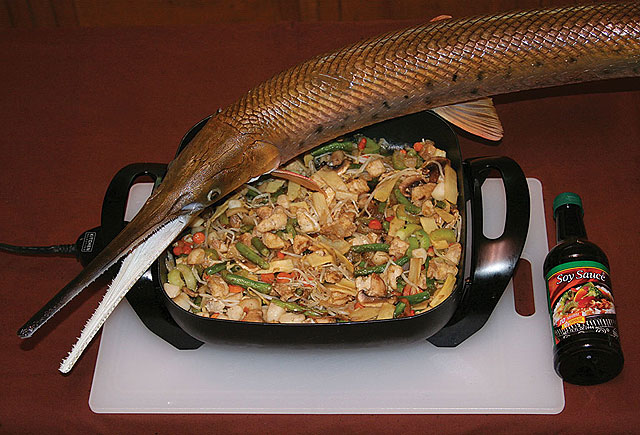
Gar frequently are attracted to the movement of shallow-running plugs, following the lure back to the boat. Sometimes they even strike the lure with such ferocity that they set the hooks.
Now that you’ve caught him, what do you do with a gar?
The smaller species, such as the shortnosed and spotted gar, yield scallop-sized fish steaks that are ideal for stir-frying with Chinese vegetables. The larger longnosed and alligator gar have steaks that may be grilled, smoked, or ground to make fish paddies or gar balls.
Alligator gar can get huge. During the 1840s fish weighing up to 600 pounds were weighed at St. Louis. Even today, some 300-pound gar are taken from the Trinity River in Texas. Hundred-pound fish are caught from the west coast of Florida throughout the Gulf Coast states.
GAR KILLING
When you have the gar in the boat, the usual way to kill it is with a strike on the top of the skull with a ball-peen hammer. Gar teeth look viscous, and they are. Do not attempt to lift a live fish by the gills. Gars have very sharp-edged scales that Indians used to tip their arrows and these easily cut skin. Those scales provide a tough armor and also present the chief difficulty in cleaning gar.
Once the fish is dead it needs to be iced as quickly as possible. I take along a 4-foot cooler loaded with ice to handle these fish. The cooler not only helps keep the meat, but also helps reduce the amount of slick gar slime o the deck of the boat.
Professional gar processors build a wooden trough big enough to hold an large gar stable and use a hatchet to cut through the thick scales along the spine, back of the head and forward of the tail. Then a knife is employed to cut back the hide on either side of the fish, allowing the removal of the back straps.
On smaller gar, cuts may be made behind the head and in front of the tail with a hatchet or heavy knife and tin snips used to cut through the scales along the backbone to expose the meat.
Be award that the eggs of gar are deadly if consumed raw or cooked. Any meat that might be contaminated with stomach contents or eggs should be removed and discarded.
Once the back straps are extracted these may be cut into meal-size sections and frozen in water to prevent freezer burn.
For smaller gar of up to 3-feet long, I cut semi-thawed backstraps into 1/4-inch slices to make an Oriental stir-fry, which is a free-form dish that can use a variety of components.
With huge gar, I grind the meat and make fish paddies. The paddies are breaded in egg batter and deep-fried. Usually I sprinkle a bit of dill on before frying.
Other recipes for both small and large gar are in my book, Practical Bowfishing. Copies are available from my Web site at www.hoveysmith.com.
ORIENTAL GAR STIR FRY
1 Pound diced, unsalted gar meat
1 large spanish onion
1/2 chopped green bell pepper with seeds
15-ounce can bean sprouts
8-ounce can drained bamboo shoots
8-ounce can drained water chestnuts
1/2 cup diced string beans or snow peas
1/4 cup sliced baby carrots
1/4 cup sliced celery
1/4 cup sliced fresh mushrooms
4 tablespoons soy sauce
Olive oil sufficient to cover the bottom of the cooking surface
Heat the olive oil in pan and add cut carrots and beans. When those soften, add fish, onions bell pepper and celery, while constantly stirring. When pan starts to dry, add bamboo shoots, water chestnuts and bean sprouts. Continue stirring as you add soy sauce and mushrooms. Cook until everything except the water chestnuts is soft. Serve over Chow Mein noodles.









